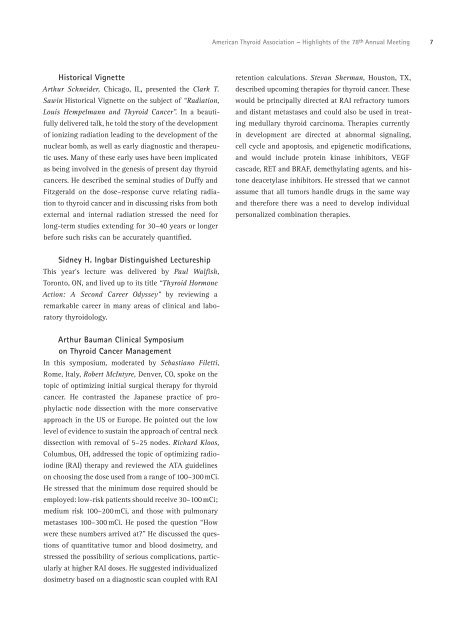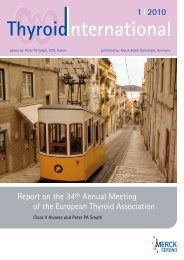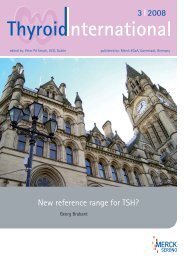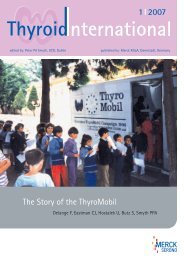6 <strong>Thyroid</strong> International 2 2008Award LecturesPaul Starr AwardDr Ken Burman, Washington, DC, in his Paul StarrAward Lecture, reviewed recent advances in <strong>the</strong> investigation<strong>of</strong> thyroid cancer. Histological variants <strong>of</strong> papillarythyroid carcinoma differ in prognosis: <strong>the</strong> tallcell variant has a worse prognosis, while <strong>the</strong> follicularvariant has a better prognosis. Vascular invasion hasa markedly worse prognosis for distant metastases. Healso reviewed biochemical features <strong>of</strong> certain cancers.Activated AKT can phosphorylate RAF, inactivating<strong>the</strong> downstream MEK–ERK pathway. Increased AKTactivity has been found in most types <strong>of</strong> thyroid cancer,but is less common in follicular adenomas. Variousdifferent tyrosine kinases have been reported to displayincreased expression in thyroid cancers: someare overexpressed because <strong>the</strong>y have become fused too<strong>the</strong>r genes, while o<strong>the</strong>r cancers display a decrease in<strong>the</strong> activities <strong>of</strong> proteins that inhibit tyrosine kinases.Tumors with foci <strong>of</strong> cells that have lost cell polarity andintracellular adhesion also show a loss <strong>of</strong> e-cadherin,which permits β-catenin to enter nuclei and activatea variety <strong>of</strong> gene pathways. These manifestations <strong>of</strong>epi<strong>the</strong>lial-mesenchymal transition are thought to promoteinvasiveness and distant metastases.Van Meter AwardThe Van Meter Award was given to Dr Yuri Nikiforov,Pittsburg, PA, who was recognized for his contributionsto <strong>the</strong> understanding <strong>of</strong> radioiodine-induced thyroidcancer. During <strong>the</strong> Chernobyl nuclear accident, a millionchildren were at risk <strong>of</strong> exposure to 4 millionCuries <strong>of</strong> 131 I released into <strong>the</strong> atmosphere. A dramaticincrease <strong>of</strong> carcinoma in <strong>the</strong> thyroid began 4 yearslater. The most salient discovery about <strong>the</strong> cancers in<strong>the</strong>se children was that chromosome rearrangements –ra<strong>the</strong>r than single base mutations – were <strong>the</strong> commonestcause <strong>of</strong> papillary carcinoma following irradiation.The commonest rearrangement (between <strong>the</strong> RET andhistone H4 genes, both being located on Chromosome10), was found in over 80 % <strong>of</strong> radiation-induced papillarycarcinoma. The second most common finding wasa BRAF/AKAP9 in-frame fusion on Chromosome 7.About 10 % <strong>of</strong> <strong>the</strong> cancers that developed after radiationhave <strong>the</strong> BRAF/AKAP 9 rearrangement, whereasin sporadic papillary carcinomas, <strong>the</strong> most commondefect is a single base mutation in <strong>the</strong> BRAF gene(~ 40 %). Although a wide variety <strong>of</strong> gene mutationshave been observed in thyroid cancer, <strong>the</strong> most commonlyencountered appears to involve activation <strong>of</strong> <strong>the</strong>MEK–ERK pathway. Nikiforov provided backgroundinformation showing that DNA exists in very largeloops, and each chromosome occupies its own specificregion within <strong>the</strong> nucleus. When a double-strand breakoccurs in DNA, <strong>the</strong> complex <strong>of</strong> proteins that forms toreunite <strong>the</strong> two strands may also be involved in causing<strong>the</strong> chromosome rearrangements. Nikiforov performedrestriction endonuclease digestions on whole cells afterX-radiating <strong>the</strong>m, and deduced that only one doublestrandedDNA preceded <strong>the</strong> chromosome rearrangementsthat occur ei<strong>the</strong>r between <strong>the</strong> RET and H4 geneor between <strong>the</strong> RET and ELE1 gene.Keynote Clinical AddressAntonio Bianco, Boston, MA, in discussing “The Role<strong>of</strong> <strong>Thyroid</strong> Hormone in <strong>the</strong> Regulation <strong>of</strong> Metabolism”reviewed <strong>the</strong> role <strong>of</strong> deiodinases (DIOs) in fat metabolism,particularly <strong>of</strong> DIO2 in brown adipose tissue.The subcellular distribution <strong>of</strong> DIOs affects <strong>the</strong> cell’sresponsiveness to T 4 : DIO1 is located on <strong>the</strong> plasmamembrane, whereas DIO2 is located in <strong>the</strong> endoplasmicreticulum around <strong>the</strong> nucleus. Thus, T 3 made by DIO2is more likely to enter <strong>the</strong> nucleus and to stay longerthan T 3 made at <strong>the</strong> cell surface by DIO1. Bianco <strong>the</strong>ndescribed <strong>the</strong> effects <strong>of</strong> bile acids on <strong>the</strong> actions <strong>of</strong>thyroid hormone on metabolism. Bile acids taken upfrom <strong>the</strong> gut spill into <strong>the</strong> systemic circulation andincrease <strong>the</strong>rmeogenesis. TGR5 is a bile acid-bindingprotein found in mature brown fat cells. He noted thatlithocholic and taurocholic acids are <strong>the</strong> most potent foractivating DIO2 in brown fat. Giving a high-fat diet toTGR5 knock-out mice causes <strong>the</strong>m to gain more weightthan do normal mice. In pre-adipocytes, bile acids notonly can change metabolism but also can cause <strong>the</strong>irdifferentiation to mature brown fat.
<strong>American</strong> <strong>Thyroid</strong> Association – <strong>Highlights</strong> <strong>of</strong> <strong>the</strong> 78 th <strong>Annual</strong> <strong>Meeting</strong>7Historical VignetteArthur Schneider, Chicago, IL, presented <strong>the</strong> Clark T.Sawin Historical Vignette on <strong>the</strong> subject <strong>of</strong> “Radiation,Louis Hempelmann and <strong>Thyroid</strong> Cancer”. In a beautifullydelivered talk, he told <strong>the</strong> story <strong>of</strong> <strong>the</strong> development<strong>of</strong> ionizing radiation leading to <strong>the</strong> development <strong>of</strong> <strong>the</strong>nuclear bomb, as well as early diagnostic and <strong>the</strong>rapeuticuses. Many <strong>of</strong> <strong>the</strong>se early uses have been implicatedas being involved in <strong>the</strong> genesis <strong>of</strong> present day thyroidcancers. He described <strong>the</strong> seminal studies <strong>of</strong> Duffy andFitzgerald on <strong>the</strong> dose–response curve relating radiationto thyroid cancer and in discussing risks from bo<strong>the</strong>xternal and internal radiation stressed <strong>the</strong> need forlong-term studies extending for 30–40 years or longerbefore such risks can be accurately quantified.retention calculations. Stevan Sherman, Houston, TX,described upcoming <strong>the</strong>rapies for thyroid cancer. Thesewould be principally directed at RAI refractory tumorsand distant metastases and could also be used in treatingmedullary thyroid carcinoma. Therapies currentlyin development are directed at abnormal signaling,cell cycle and apoptosis, and epigenetic modifications,and would include protein kinase inhibitors, VEGFcascade, RET and BRAF, demethylating agents, and histonedeacetylase inhibitors. He stressed that we cannotassume that all tumors handle drugs in <strong>the</strong> same wayand <strong>the</strong>refore <strong>the</strong>re was a need to develop individualpersonalized combination <strong>the</strong>rapies.Sidney H. Ingbar Distinguished LectureshipThis year's lecture was delivered by Paul Walfish,Toronto, ON, and lived up to its title “<strong>Thyroid</strong> HormoneAction: A Second Career Odyssey” by reviewing aremarkable career in many areas <strong>of</strong> clinical and laboratorythyroidology.Arthur Bauman Clinical Symposiumon <strong>Thyroid</strong> Cancer ManagementIn this symposium, moderated by Sebastiano Filetti,Rome, Italy, Robert McIntyre, Denver, CO, spoke on <strong>the</strong>topic <strong>of</strong> optimizing initial surgical <strong>the</strong>rapy for thyroidcancer. He contrasted <strong>the</strong> Japanese practice <strong>of</strong> prophylacticnode dissection with <strong>the</strong> more conservativeapproach in <strong>the</strong> US or Europe. He pointed out <strong>the</strong> lowlevel <strong>of</strong> evidence to sustain <strong>the</strong> approach <strong>of</strong> central neckdissection with removal <strong>of</strong> 5–25 nodes. Richard Kloos,Columbus, OH, addressed <strong>the</strong> topic <strong>of</strong> optimizing radioiodine(RAI) <strong>the</strong>rapy and reviewed <strong>the</strong> ATA guidelineson choosing <strong>the</strong> dose used from a range <strong>of</strong> 100–300 mCi.He stressed that <strong>the</strong> minimum dose required should beemployed: low-risk patients should receive 30–100 mCi;medium risk 100–200 mCi, and those with pulmonarymetastases 100–300 mCi. He posed <strong>the</strong> question “Howwere <strong>the</strong>se numbers arrived at?” He discussed <strong>the</strong> questions<strong>of</strong> quantitative tumor and blood dosimetry, andstressed <strong>the</strong> possibility <strong>of</strong> serious complications, particularlyat higher RAI doses. He suggested individualizeddosimetry based on a diagnostic scan coupled with RAI






